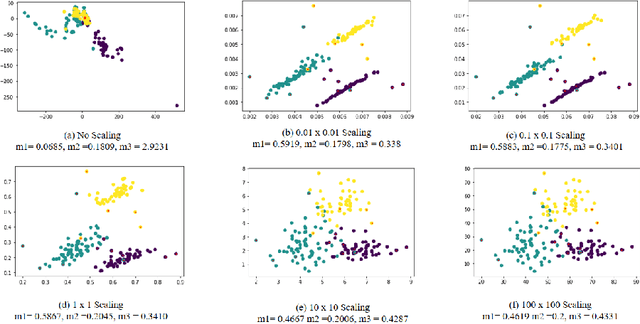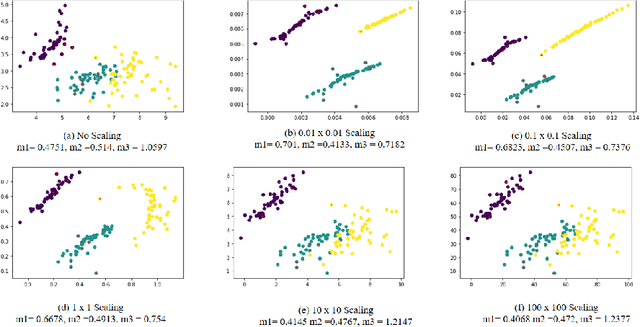Maniru Ibrahim
Improving multidimensional projection quality with user-specific metrics and optimal scaling
Jul 23, 2024Abstract:The growing prevalence of high-dimensional data has fostered the development of multidimensional projection (MP) techniques, such as t-SNE, UMAP, and LAMP, for data visualization and exploration. However, conventional MP methods typically employ generic quality metrics, neglecting individual user preferences. This study proposes a new framework that tailors MP techniques based on user-specific quality criteria, enhancing projection interpretability. Our approach combines three visual quality metrics, stress, neighborhood preservation, and silhouette score, to create a composite metric for a precise MP evaluation. We then optimize the projection scale by maximizing the composite metric value. We conducted an experiment involving two users with different projection preferences, generating projections using t-SNE, UMAP, and LAMP. Users rate projections according to their criteria, producing two training sets. We derive optimal weights for each set and apply them to other datasets to determine the best projections per user. Our findings demonstrate that personalized projections effectively capture user preferences, fostering better data exploration and enabling more informed decision-making. This user-centric approach promotes advancements in multidimensional projection techniques that accommodate diverse user preferences and enhance interpretability.
A new visual quality metric for Evaluating the performance of multidimensional projections
Jul 23, 2024



Abstract:Multidimensional projections (MP) are among the most essential approaches in the visual analysis of multidimensional data. It transforms multidimensional data into two-dimensional representations that may be shown as scatter plots while preserving their similarity with the original data. Human visual perception is frequently used to evaluate the quality of MP. In this work, we propose to study and improve on a well-known map called Local Affine Multidimensional Projection (LAMP), which takes a multidimensional instance and embeds it in Cartesian space via moving least squares deformation. We propose a new visual quality metric based on human perception. The new metric combines three previously used metrics: silhouette coefficient, neighborhood preservation, and silhouette ratio. We show that the proposed metric produces more precise results in analyzing the quality of MP than other previously used metrics. Finally, we describe an algorithm that attempts to overcome a limitation of the LAMP method which requires a similar scale for control points and their counterparts in the Cartesian space.
 Add to Chrome
Add to Chrome Add to Firefox
Add to Firefox Add to Edge
Add to Edge